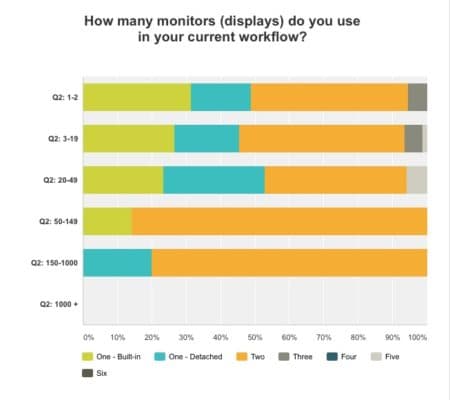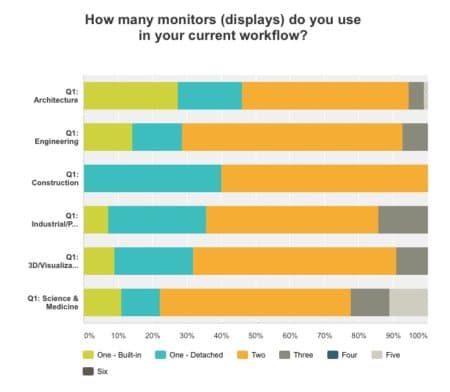Let’s get something clear immediately. Apple’s surprising news about its commitments to Mac pros was a just-in-time blessing. But pros everywhere still need to wait for the machines Schiller and Federighi are hoping will make up for the hurt Apple has brought upon its most loyal and longtime users—Mac professionals.
With that said, let’s try to shed some research light on what Apple will have to do to hit it out-of-the-park for at least one constituency we know really well here at Architosh: Architects.
The Future iMac (Pro?) vs. the next Mac Pro
It used to be any serious architect working on the Mac was using their pro desktop solution (e.g., PowerMac or later Mac Pro). Or, if they needed a lot of mobility they would use something like the Titanium Macbook Pro. But for the desktop users, architects did not mess about with the early iMacs. Then things started changing when the i7 based iMacs came around. Architects found out that compared to the cost of the new 2013 Mac Pro, there was simply a better value in an i7-based iMac.

00 – Should Apple consider making one of these an iMac Pro? Architosh has collected data that strongly suggest that the iMacs keep getting so powerful that they suite a large class of pro users who previously used pro towers.
MORE: Is the new Retina iMac the “iMac Pro” the market seems to be screaming for?
So when Architosh published a story on the concept of an iMac Pro and followed up with this idea in its workstation survey, survey participants in the architecture field wrote in with statements like this:
“While [an] iMac Pro is often considered ideal for architectural professionals, one of the reasons why this is has to do with price-point and a convenience factor. However, some find the integration of the CPU and screen a negative of the machine, begging the question of whether or not Apple could devise a mutual pairing of the Mac mini with a Cinema Display for an integrated look.” — participant #A334
It’s true some pro users in the architecture field suggest that an integrated display is an inconvenience; however, according to our data, for architecture users, it’s not the built-in nature of the display that would decide against a new iMac Pro versus the next Mac Pro, but rather how easy and affordable Apple could provide a matching second monitor or not¹ and how powerful and costly the machine would be compared to the entry point of the next Mac Pro.
The Truth About Two Displays
Our survey data shows that 48 percent of all participants from the Architecture industry currently use two monitors. Having been inside a range of Boston area architecture firms over the past few years, for various reasons, my anecdotal evidence strongly suggests that percentage is pretty accurate. But how accurate?
One way to look at this is from the point of view of firm size. In the Architecture industry, there is very accurate data about firm-size, and what percentages of professionals work in what size firms. Over 80 percent of architects work in small firms or in solo practices (i.e., 3-19 or 1-2). So take a look at the chart below—it shows display use preferences by firm-size for just the Architecture industry participants in our research.

01 – For the Architecture industry, monitor use based on our research data shows high usage of two displays. Larger firms in particular use two displays as standard. (image: Architosh Research. All rights reserved.)
Not too surprisingly, mid-sized practices (20-49 people) use one display the most, while smaller firms and sole practitioners appear to use two or more monitors a bit more. And large and enterprise scale firms, which are less than 5 percent of architecture practices, use two monitors as standard even more. We can also see that mid-sized firms use many more single detached displays. (see image 01) As firms go up in size their usage of Macs decreases while usage of PCs increases leading to detached screens.
Splitting hairs about accuracy aside, here’s the truth though about two displays in the Architecture industry: they matter.
How Apple Can Meet Both Demands
A key reason why the iMac as a pro desktop computer is attractive to the architectural professional has a lot to do with their needs, which are largely bound up in single-threaded CAD and BIM applications. BOXX has told Architosh several times their most popular workstation by units sold is their Intel i7 high-frequency system. And for the architectural industry, they have published many guides on such systems for the workflows that architects need.
Systems with tons of CPU cores cost much more but don’t deliver the actual bang for the buck due to the apps used predominantly in architecture practices. The more senior an architect is the far less likely they do any visualization work (renderings and animations) the one clear area where adding CPU cores really pays off.
But what does pay off for productivity is having two displays. What Apple must do for its future iMac that is more geared for professionals is make sure it works well with a “paired” second monitor. But Apple already makes hooking up a second monitor to an iMac easy. What Apple should do is make sure they can provide a visually matching and aligning setup.¹
Overlap the New Mac Pro
The other thing they must do is deliver an overlap with the low-end spectrum of the new Mac Pro, oriented at the professional who needs a bit more cores in their CPU because they use them. Maybe they use ARCHICAD, one BIM app that does indeed benefit from more cores. Or maybe they do a fair amount of rendering.
For the user (survey participant) cited above, who desires truly independent detached monitor use but is attracted to the cost-efficiencies and benefits of the iMac Pro concept idea, Apple needs to offer a new Mac Pro that reaches down to that price point of whatever will be the pro-oriented end of the new upcoming iMac. This will assure them that no possible adopter or user slips through a price crack wherein they can’t find a good price/performance fit for them.

02 – When looked at by industry, Architecture ranks lowest for multiple display use as engineering, 3D/visualization, science and medicine all have higher usage of multiple displays. (image: Architosh Research. All Rights Reserved.)
In the chart above we see that in Architecture the use of a single display (attached or detached) is highest among all the industries surveyed, including Construction. (see image 02) Engineering, and Medicine and Science have the greatest need for two or more monitors. And the latter in particular has the greatest need for tons of CPU cores.
But I hope whoever is studying pro markets at Apple is informed enough to know where each market is headed. Talking to a few customers isn’t a guarantee Apple is getting the information they truly need.
Increasing CPU Cores in Architecture
For example, these days architectural professionals are increasingly getting involved in visualization work. Whether it be in the new real-time, interactive rendering tools, the VR-oriented workflows that come out of game engines like Unity, or in high-end still image visualization tools coming down-market through simplification like the latest releases of V-Ray. Visualization software tends to take advantage of more CPU cores.
This means one obvious way to excite architects with a pro-oriented iMac is to offer more CPU cores than the standard models. An 8-core version with superb GPU options could become a standard issue machine in many architecture practices—particularly ARCHICAD firms because that BIM application utilizes those cores.
Likewise, for architects using Revit or SketchUp or a host of other things, having a new Mac Pro that is an affordable path for a high-frequency Mac (for titillating single-threaded performance, a la, what BOXX offers), this too would be a popular option.
Closing Comments
The bottom line is Apple needs to provide overlapping options for the Architecture industry wherein the top iMac and the lowest-end Mac Pro address a common price point range but with a different set of tradeoffs. Otherwise, if not done properly the Architecture industry will again be left wanting.
In particular, users want blazing single-threaded performance. That will be best met in a larger enclosure in the new Mac Pro. Likewise, “pro” like features of value to the Architecture industry added to the next iMac would involve more CPU cores and even better GPU options (can we say “VR” anyone?) Yes! both the next iMac and the Mac Pro should support VR robustly. Let’s hope Apple can pull this all off.
Footnotes
- “How easy and affordable” means, in this case, an aesthetically matching, same-sized, height-aligning complimentary second display that is Apple produced and decently priced.
Architosh Mac Workstation Market Research
For those interested, our workstation research study from 2014 is still running. We originally published findings on Architosh at a broad level. We have new plans for how the deeper, in-depth reports will be published (which can be found here).



Reader Comments
Comments for this story are closed